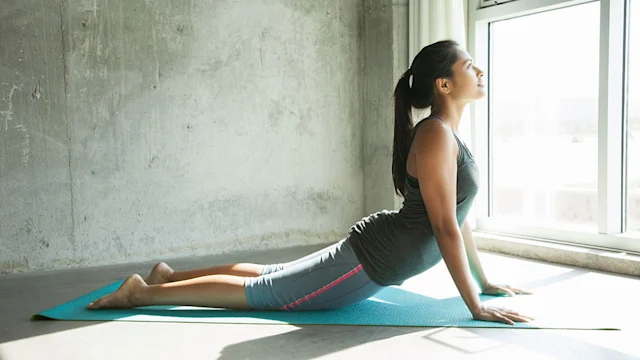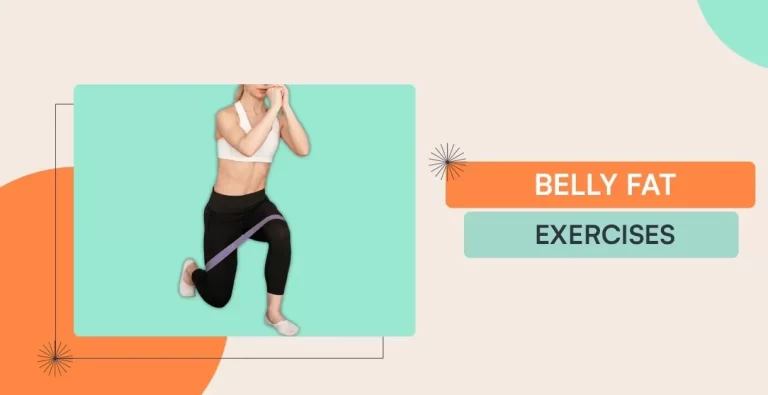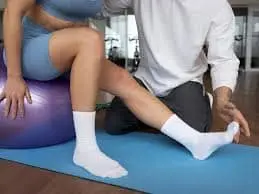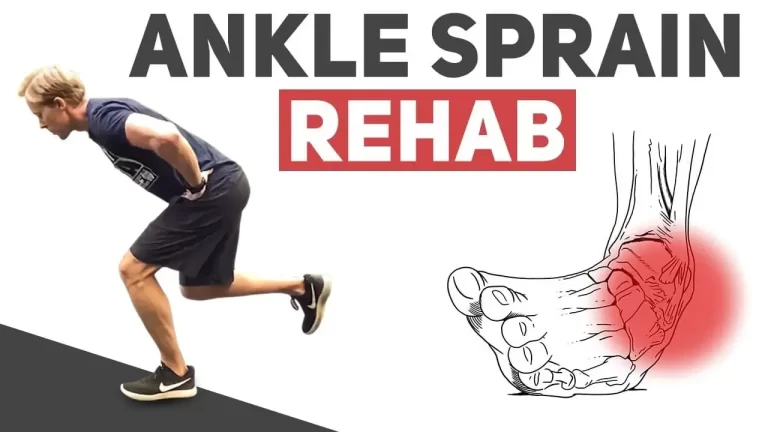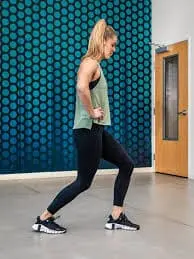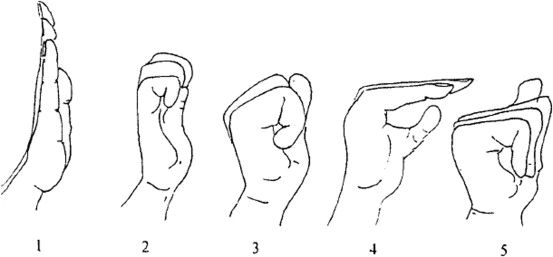16 Best Stretching Exercises for Low Back Pain
Targeted Stretching Exercises for Low Back Pain are the safest and most efficient strategies to treat and prevent low back pain. This article will cover the advantages of stretching and provide a detailed guide to the most effective stretches for relief.
Introduction:
Pain in the lower back can be one of the most common physical problems. Back pain, whether caused by bad posture, prolonged sitting, physical labor, or an accident, can have significant adverse effects on day-to-day activities and general quality of life. Targeted Stretching Exercises for Low Back Pain are the safest and most efficient strategies to treat and prevent low back pain. Lower back stretches can increase blood flow and engage the muscles there.
Lower back pain may restrict movement and interfere with day-to-day activities. It comes in two varieties: acute, which lasts a few days to six weeks, and chronic, which lasts for more than three months to years. If left untreated, problems with your back may negatively affect your quality of life and make regular duties hard. In certain situations, pain may radiate into the lower leg region, the thigh, or one or both buttocks.
Causes:
A large portion of the weight of the upper body is supported by the lumbar area or lower back. It comprises nerves, ligaments, muscles, discs, and vertebrae.
- Muscle strain or sprain
- Poor posture
- Sedentary lifestyle
- Herniated discs
- Sciatica
- Osteoarthritis
- Spinal stenosis
With the right stretching and lifestyle modifications, many mild to moderate cases can recover, but severe or chronic cases may need medical intervention.
Advantages of stretching:
Improves Mobility and Flexibility
- Regular stretching contributes to restoring these muscles’ strength and mobility.
- This lessens the possibility of unexpected strains and allows more painless, fluid movement.
- Your ability to carry out everyday duties and participate in physical exercise improves when you have greater mobility, which promotes spinal health.
Promotes Better Spinal Alignment and Posture
- By restoring proper muscle length and function, stretching important muscle groups (such as the lower back, hamstrings, and hip flexors) helps to address postural abnormalities.
- Better posture lessens abnormal tension and wear on the vertebrae and discs by distributing spinal stresses more evenly.
Increases Daily Performance and Functional Movement
- In daily activities, more effective and comfortable mobility is made possible by increased range of motion and decreased pain.
- In physical activities, you restore your sense of confidence and independence, improving your quality of life.
Encourages Pelvic and Core Balance
- You can restore muscular balance and lessen the strain on spinal structures by releasing too-tense muscles, such as the quadratus lumborum, piriformis, or hip flexors.
- Stabilizing the spine and avoiding unnecessary motion that can cause injury are made possible by a healthy core and pelvis.
Lessons Spasms and Tension in the Muscles
- Specific stretches promote muscular lengthening and relaxation, releasing tension and reducing hyperactive nerve signals that cause spasms.
- There will be fewer episodes and less need for painkillers or other treatments if there is less muscle tightness.
Increases the Circulation of Blood
- Injured tissues receive oxygen and nutrients via the increased circulation in and around the lower back, which helps in the removal of waste.
- Increased circulation promotes improved tissue health overall, less pain, and a quicker recovery.
Reduce stress
- You are less prone to experience chronic pain patterns linked to emotional stress, feel more at ease, and have greater control over your pain.
Prevents Injuries and Recurrences in the Future
- It encourages movement patterns and flexibility, which lower risk factors like poor body mechanics, tight joints, and weak core support.
- Constant stretching reduces the frequency of pain recurrence and strengthens the back’s endurance.
Stretching Exercises for Low Back Pain:
Piriformis stretch
- On your back, lie down.
- After that, both knees were bent, and the feet were flat on the ground.
- On the left leg, just above the knee, the right ankle should be crossed.
- Next, carefully move your left thigh up to your chest.
- Your right hip and buttocks should feel stretched.
- Hold this position for a few seconds.
- Then return to your neutral position.
- Then relax.
- Repeat these exercises 5 to 10 times.
- Stretch the opposite side again.
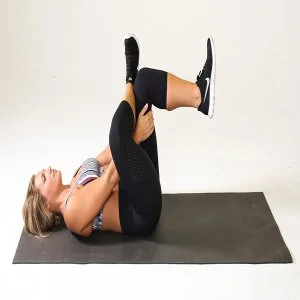
Open Book Stretch
- Start by lying sideways on the ground.
- Place your hands towards each other and straighten your arms in front of you.
- Like you would with a book, gradually open your upper arm and move it across your body to the other side.
- Let your head and upper body rotate naturally as you perform the movement.
- When you move your upper back and shoulder blades into touch with the floor, try to keep your legs together and moving.
- Hold this position for a few seconds.
- Then return to your neutral position.
- Then relax.
- Repeat these exercises 5 to 10 times.
- Stretch the opposite side again.
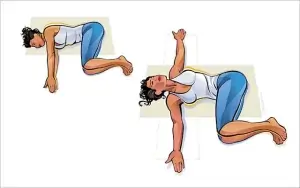
Supine Spinal Twist
- Resting on your back.
- Bend and point your right knee toward your chest.
- Using your left hand, carefully move your right knee to the left across your body.
- Extend your right arm out to the side and turn your head to the right if it feels comfortable.
- Make an effort to maintain both shoulders as flat as possible on the floor.
- Hold this position for a few seconds.
- Then return to your neutral position.
- Then relax.
- Repeat these exercises 5 to 10 times.
- Stretch the opposite side again.
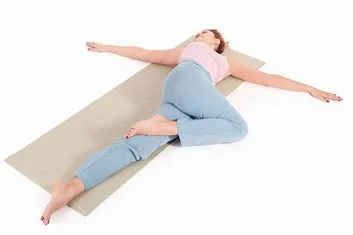
Child’s Pose
- Begin by arranging yourself on the floor like a tabletop position.
- Stretch your knees apart comfortably while putting your big toes together.
- Sit back toward your heels with your hips gently.
- Lift your arms forward, palms down.
- Place your forehead on the floor.
- Deeply inhale into your sides and lower back.
- Hold this position for a few seconds.
- Then return to your neutral position.
- Then relax.
- Repeat these exercises 5 to 10 times.
- Stretch the opposite side again.
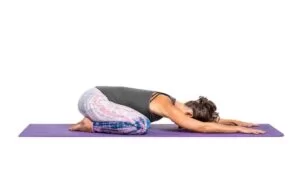
Thread the Needle
- Start by lowering yourself to a tabletop position on your hands and knees.
- Taking a breath, thread your right arm across your body, palm facing up, reaching it beneath your left arm.
- Maintaining a high and level hip position, let your right shoulder and right ear rest on the mat.
- By stretching forward or maintaining your left hand on the floor for support, you can prolong the stretch.
- Hold this position for a few seconds.
- Then return to your neutral position.
- Then relax.
- Repeat these exercises 5 to 10 times.
- Stretch the opposite side again.
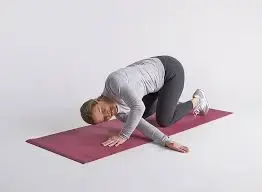
Knee-to-chest stretch
- Start with supine position on the floor.
- Using both hands, carefully pull your right knee toward your chest while bending it.
- Keep your left leg straight.
- Maintain your lower back neutral on the floor.
- Hold this position for a few seconds.
- Then return to your neutral position.
- Then relax.
- Repeat these exercises 5 to 10 times.
- Continue stretching on the opposite side.
- Stretch the opposite side again.
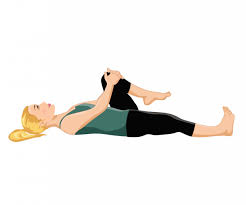
Cat-Cow stretch
- Start with a kneeling position on the ground.
- Take a breath and arch your back.
- Lower your abdomen to the ground.
- Raise your head and chest a little.
- Then tilt your pelvis.
- Hold this position for a few seconds.
- Breathe out and turn your back.
- Squeeze your abdominal muscles.
- Make sure to tuck your tailbone in.
- Gently tuck your chin into your chest.
- Hold this position for a few seconds.
- Go between these two positions slowly and carefully.
- Then return to your neutral position.
- Then relax.
- Repeat these exercises 5 to 10 times.
- Stretch the opposite side again.
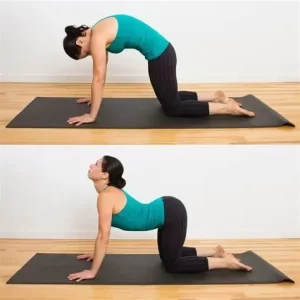
Hamstring stretches
- Start with lying down on the floor.
- Loop a towel, belt, or strap around the ball of one leg as you raise it.
- Using both hands, grasp the strap.
- Pull your leg toward you slowly.
- Try to maintain a neutral lower back and a straight knee.
- To increase the stretch and keep the knee from being overly stressed, flex your foot.
- Hold this position for a few seconds.
- Then return to your neutral position.
- Then relax.
- Repeat these exercises 5 to 10 times.
- Stretch again on the opposite side.
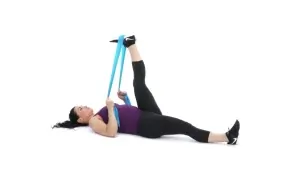
Sphinx stretch
- Start by resting on your stomach on the ground.
- To prevent extending your lower back, gently engage your thighs while pressing the tops of your feet into the ground.
- Take a breath, raise your chest off the ground, extend your spine, and gently press your elbows into the mat to produce a small backbend.
- Hold this position for a few seconds.
- Maintain a light floor-based pelvis to prevent overstressing your lower back.
- Then return to your neutral position.
- Then relax.
- Repeat these exercises 5 to 10 times.
- Stretch the opposite side again.
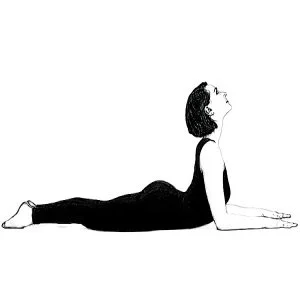
Seated-spine-twist
- With your knees at a 90-degree angle and your feet flat on the floor, take a comfortable seat on a supportive chair.
- Straighten your back and inhale deeply.
- Exhale, place your left hand on your right knee, and tilt your upper body slightly to the right.
- The twist gets deeper when you turn your head to see over your right shoulder.
- Hold this position for a few seconds.
- Then return to your neutral position.
- Then relax.
- Repeat these exercises 5 to 10 times.
- Stretch the opposite side again.
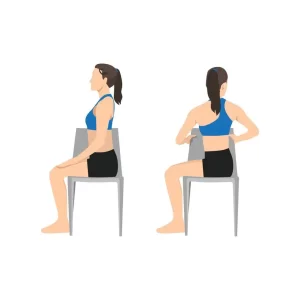
Legs-Up-the-Wall
- With your knees bent and one hip close to the wall, take a sideways seat next to a wall.
- Make sure your back is facing the floor as you gently move your legs up the wall.
- Your legs should be fully stretched, and your hips should be toward the wall.
- Ensure that your back is flat on the floor and that your legs are about ninety degrees from the wall.
- Allow your arms to fall to your sides while keeping your hands up or, for added comfort, resting on your tummy.
- Hold this position for a few seconds.
- Then return to your neutral position.
- Then relax.
- Repeat these exercises 5 to 10 times.
- Stretch the opposite side again.
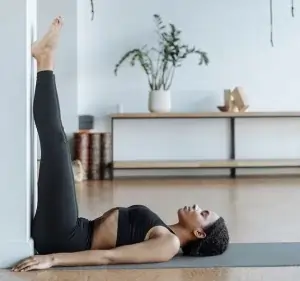
Lower back stretch
- Start by resting on your back on the ground.
- Next, bend both knees.
- Using both hands, hold your legs together and lift them up to your chest.
- Maintaining a relaxed lower back on the floor, gently draw your knees toward your chest.
- Maintain a relaxed posture and concentrate on taking deep breaths.
- Hold this position for a few seconds.
- Then return to your neutral position.
- Then relax.
- Repeat these exercises 5 to 10 times.
- Stretch the opposite side again.
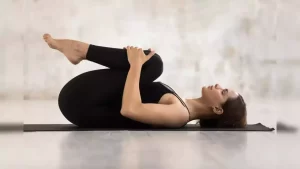
Pelvic tilts
- On a solid comfortable surface, lie on your back.
- Next, bend both knees.
- Lay your arms palms down at your sides.
- Breathe in, letting your back keep its natural curve and your belly grow.
- Exhaling ought to lead your abdominal muscles to engage.
- Following that, raise your pelvis to gently press your lower back against the floor.
- Hold this position for a few seconds.
- Then return to your neutral position.
- Then relax.
- Repeat these exercises 5 to 10 times.
- Stretch the opposite side again.
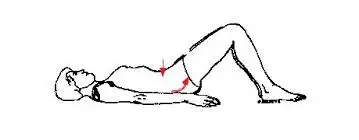
Cobra stretch
- With your legs outstretched and your feet flat on the floor, lie face down on a mat.
- Squeeze your glutes and abdominal muscles.
- Inhale, then slowly press onto your hands to lift your chest off the floor.
- Make sure your elbows are slightly bent.
- Only raise as much as is comfortable; initially, this may only be a few inches.
- Hold this position for a few seconds.
- Then return to your neutral position.
- Then relax.
- Repeat these exercises 5 to 10 times.
- Stretch the opposite side again.

Poodle tail lower back stretch
- On a mat, begin in a quadrupedal position with your hands and knees.
- The spine is in a neutral posture.
- With your back flat and your core strong, move your hips from side to side as though you were attempting to “move your tail” in the direction of your ribs.
- Hold this position for a few seconds.
- After you’ve returned to the middle, move your left hip toward your left shoulder.
- Move gently and cautiously while maintaining an upright upper body.
- Then return to your neutral position.
- Then relax.
- Repeat these exercises 5 to 10 times.
- Stretch the opposite side again.
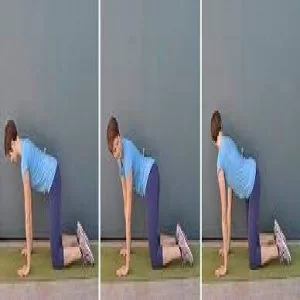
Lower-back-rotational-stretch
- Place your feet flat on the floor and bend both knees while lying on your back.
- Palms facing up, spread your arms out to the sides in a “T” shape.
- Lower both knees slowly to one side, letting your trunk rotate, while maintaining a flat shoulder position on the floor.
- Hold this position for a few seconds.
- Return to the middle slowly, then switch to the other side and repeat.
- Then return to your neutral position.
- Then relax.
- Repeat these exercises 5 to 10 times.
- Stretch the opposite side again.
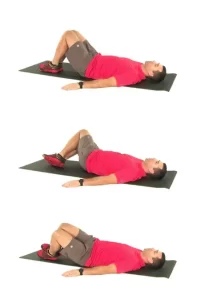
What safety measures need to be followed when stretching?
Safety is essential when doing low back pain stretching exercises to avoid extra strain or injury.
Important safety precautions:
Start with warming up.
- Before stretching, start with five to ten minutes of gentle exercise, such as walking or marching in place, to improve blood flow and relax muscles.
Stretch slowly and gently.
- Take your time getting into each stretch.
- Muscle strain or tearing may result from rapid and jerky motions.
Don’t Overstretch
- It’s not always better to have more.
- Stretching too much may worsen pain or harm muscles.
Inhale Regularly
- During stretches, take calm, deep breaths to help your body relax.
- Don’t hold your breath.
Hold Every Stretch Consistently
- Ten to thirty seconds should be held for each stretch for up to three repetitions.
- Instead of bouncing, remain stable in the position.
Avoid putting yourself through pain.
- Instead of producing a severe, stabbing, or searing pain, stretching should provide a slight tension or pulling sensation.
- If you feel any pain, stop immediately.
Adjust or Remove Specific Stretches
- Certain stretches (such as forward bends or twists) may make your symptoms worse if you have spinal stenosis, sciatica, or disc issues.
Pay Attention to Correct Form
- As you perform each stretch, keep your posture straight.
- Don’t overarch or collapse your spine; instead, gently engage your core.
If necessary, use objects.
- If you require additional balance or have restricted flexibility, support your body using a pillow, towel, or yoga block.
Remain Calm and Avoid Being Aggressive
- It is safer and more effective to stretch gently every day as opposed to aggressively or infrequently.
- Consider long-term improvement rather than immediate results.
When is the right time to quit stretching?
The goal of the stretch and your body’s signals will decide whether you continue or stop performing low back pain stretching exercises.
The following essential guidelines will assist you in deciding when to stop:
Your pain is sharp or radiating.
- A little pain is acceptable, but intense pain or pain that radiates down your legs is cause for concern. Stop right away.
Your form begins to break.
- Bad posture can make stretches less effective and raise the risk of injury. If you are unable to maintain proper form, take a break and rest.
Your Limit of Flexibility Has Been Reached
- Stretch till a slight tension is felt instead of pain.
- Pushing past this point could worsen back pain or tear muscles.
You’ve Managed to Hold the Stretch Long Enough
- A majority of individuals can stretch for 10 to 30 seconds at a time.
- If it’s a part of your warm-up or rehabilitation program, repeat it two to four times per muscle group.
You Experience More Muscle Spasms or Tightness
- While some muscle resistance is normal, cramping or tightness is an indication that you should rest.
How can people prevent low back pain?
Preventing lower back pain requires adopting healthy behaviors that ease the strain on the lower back and support the spine.
The following are important ways:
Maintain Proper Posture
- Make use of lumbar-supporting chairs.
- Stay upright, especially when using computers or phones.
Develop Core Strength
- The spine is supported by a strong core, which includes the obliques, lower back muscles, and abs.
- Incorporate core-focused exercises into your routine.
Keep Your Weight in Check
- Carrying too much weight strains the spine, especially around the middle.
- Maintaining a proper weight can be facilitated by regular exercise and a healthy diet.
Maintain Your Physical Activity Level
- Frequent exercise builds core and back strength.
Control Your Stress
- Chronic stress can cause back stiffness.
- Try relaxation techniques.
Stay away from extended sitting.
- At 30- to 60-minute intervals, take a walk, stretch, or stand.
- Use a standing desk or sit-stand workplace if possible.
Put on supportive footwear.
- Shoes with enough arch support promote healthy spinal alignment.
- When standing or walking for extended periods, stay away from high heels or unsupportive shoes.
Lifting Correctly
- Be careful not to twist and keep items close to your body when lifting.
Sleep Wisely
- On a comfy mattress, sleep on your side with a cushion between your knees.
- You may get a lower back strain if you sleep on your stomach.
When to Consult a Physician:
Although many people find that stretching helps, you should see a physician or physical therapist if:
- The pain radiates down your leg or is intense and sharp.
- You experience muscle weakness, tingling, or numbness.
- The duration of your back pain is more than a few weeks.
- You recently underwent surgery or suffered a spinal injury.
Summary:
Frequent stretching is an excellent method to develop and keep flexibility, reduce stress, and help in strength development.
One easy yet effective strategy to treat and avoid low back pain is to perform stretches. They can greatly lessen pain, increase mobility, and promote a healthier spine when done correctly and on a regular basis. For best long-term effects, combine stretching with core strengthening, proper posture, and consistent exercise.
Numerous factors can contribute to lower back pain, which is frequent. Certain stretches might increase the flexibility of the affected muscles and reduce pain in the back. As you do these stretches, take your time and pay attention to your breathing. To avoid straining or going overboard, use your breath as a guide. With every position or stretch, take deep, easy breaths.
FAQ:
Which exercises incorporate stretching for low back pain?
Exercises that stretch the muscles and soft tissues surrounding the lower back, hips, and pelvis can help prevent or lessen back pain by increasing flexibility and releasing tension in these areas.
Can low back pain be relieved by stretching?
Indeed, stretching regularly and gently can help release tension, improve posture, and improve blood flow to the muscles all of which can lessen low back pain.
How often should I stretch if I’m experiencing low back pain?
Stretching should ideally be done three to five times a week, or perhaps every day. The key here is regularity.
What are the most effective stretches for reducing low back pain?
Stretches that are frequently advised include:
Child’s Pose
Cat-Cow Stretch
Knee-to-Chest Stretch
Piriformis Stretch
Seated Forward Bend
Supine Twist
Hip Flexor Stretch
Sphinx stretch
Cobra stretch
Can low back pain be effectively relieved by yoga poses?
Indeed. When performed correctly, yoga movements like Cobra Stretch, Sphinx Pose, and Downward Dog can be especially helpful.
People who have back problems should avoid certain stretches, right?
Avoiding:
Deep backends.
Touching toes while knees are locked.
Twists with improper shape If you already have back problems, always get advice from a doctor or physical therapist before attempting new stretches.
Will stretching make your back pain worse?
Incorrect or overly forceful stretching may worsen pain. Start gently at all times, and stop if you feel sudden, serious pain.
Should I stretch after warming up?
Yes. A quick warm-up, such as five to ten minutes of walking, improves blood flow and lowers the chance of injury.
Should I see a doctor before starting a stretching regimen?
It’s best to speak with your doctor first if you have chronic or severe back pain, have just had surgery, or have other health concerns.
If I have lower back pain, are there some stretches I should stay away from?
Indeed. If not recommended by a specialist, stay away from these:
Standing up and touching your toes could place too much strain on your spine.
Extreme twists or full backbends might put strain on the spinal discs.
Lifting both legs at once puts more strain on the lower back.
Which is better for back pain: stretching in the morning or at night?
Each has advantages:
Morning: Assists in loosening up the spine and getting it ready for the day.
Evening: Encourages healthier sleep by releasing tension that has built up from daily activities.
References:
- Rajput’s 2022 Lower Back Muscles Stretching workout
- Cronkleton (2024) lists seven lower back stretches to reduce pain and improve range of motion.
- Lower back pain exercises – 2025 – Expert
- 4 Easy Lower Back Pain Stretches | Abbott Newsroom – 2025
- 13 lower back pain exercises you can perform anywhere by 2025 Physio
- Stretching to relieve back pain (Gomez, 2017)
- Cadman’s 2025 guide on lower back strengthening
- Pain relief is possible with these lower back stretches and exercises – 2025 – Clinic.
- Stretching to relieve low back pain – 2022 Godman
- Seven stretches that specialists recommend for lower back pain Weg, Wellbank, 2024

